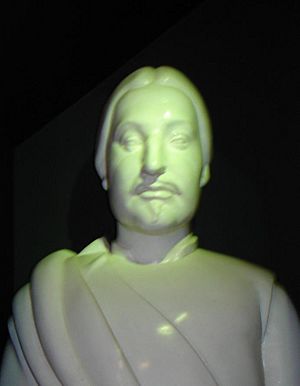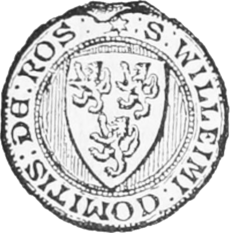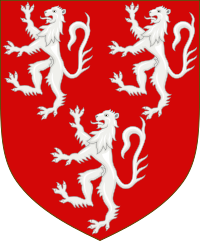William II, Earl of Ross facts for kids
Quick facts for kids
William
|
|
|---|---|

A bust of William, made for display in the Tain & District Museum
|
|
| Mormaerdom | Ross |
| Successor | Hugh, Earl of Ross |
| Born | bef. 1274 |
| Died | c. 1323 Delny, Ross-shire, Scotland |
| Family | Ross |
| Wife | Euphemia |
| Father | William I, Earl of Ross |
William II, Earl of Ross (who spoke Gaelic and was called Uilleam) was an important leader in northern Scotland. He ruled the area known as Ross and played a big part in the Wars of Scottish Independence. He lived until about 1323.
Contents
Early Life and Role in Scotland
William was the only child of William I, Earl of Ross. His mother was Jean Comyn. He became the Earl of Ross when his father passed away in 1274.
Choosing a King
In 1284, William joined other Scottish nobles. They agreed that Margaret, Maid of Norway should be the next ruler of Scotland. This happened after King Alexander III died without a son.
After Margaret also died, Scotland faced a big problem. Many people wanted to be king. William sometimes supported Scotland's side and sometimes England's side. In 1291, he showed respect to Edward I of England. Edward I was the King of England and claimed to be the overlord of Scotland.
William was chosen to help decide who would be the next King of Scotland. He listened to the arguments between John Balliol and Robert Bruce. King Edward I was the one who made the final decision.
Wars of Scottish Independence
The Wars of Scottish Independence were a series of battles. Scotland fought to remain an independent country.
Battle of Dunbar
In 1296, William was a leader in the Scottish army. This was at the Battle of Dunbar. King Edward I of England had invaded Scotland. He was angry because John Balliol, the Scottish king, would not help him fight France.
The Scottish army lost the battle. William was captured by the English. He was sent to the Tower of London, a famous prison. He stayed there for many years, until September 1303.
He was then allowed to return to Scotland. He reached Perth in December. He stayed there with Edward, Prince of Wales for a while. In February, he was finally sent home. Later in 1304, he met King Edward I again. The King gave him gifts like a horse and armor. He also made William a Warden, a leader in charge of the area beyond the Spey.
A Difficult Choice
In 1306, Robert the Bruce was fighting to become King of Scotland. His wife, Elizabeth, and his daughter, Marjorie, were trying to escape the English army. They sought safety in a church at Tain in Ross.
However, William captured them. He handed them over to the English. They were sent to England as prisoners. Some of the women were kept in cages outdoors for four years. They were not set free until 1314.

This act put William in a tough spot. Robert the Bruce was gaining power. William found himself under attack from Robert the Bruce in the south. He was also attacked by Lachlann Mac Ruaidhrí in the west.
Toward the end of 1307, William gave up to King Robert. This happened at Urquhart Castle, which William had been holding for King Edward II. King Robert gave William a break from fighting until the next summer. In return, King Robert gained control of Caithness, Sutherland, and Ross. King Robert showed mercy, even though William had betrayed his family.
In 1308, Edward II wrote to William, thanking him for his help. He asked for more support. But in that same year, William officially gave up to King Robert at Auldearn Castle. William later wrote to Edward II. He apologized for joining King Robert and asked for help to fight off Robert's invasion of Ross.
Later Life and Family
Despite his changing loyalties, William's name is on the Declaration of Arbroath. This important letter was sent to the Pope in 1320. It asked the Pope to recognize Scotland as an independent country. The Pope agreed.
William passed away three years later, around 1323, in Delny, Ross. He was married to a woman named Euphemia. She was likely the daughter of Sir Hugh de Berkeley. William and Euphemia had three sons and two daughters:
- Hugh, Earl of Ross
- Sir John Ross, who married Margaret Comyn
- Sir Walter Ross, who died at the Battle of Bannockburn
- Isabella Ross, who married Edward Bruce, Earl of Carrick
- Dorothea Ross, who married Torquil MacLeod of Lewis


